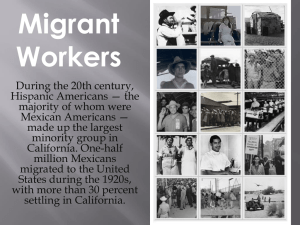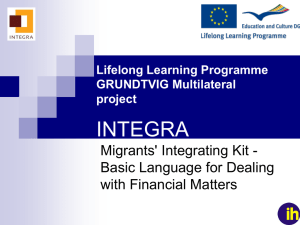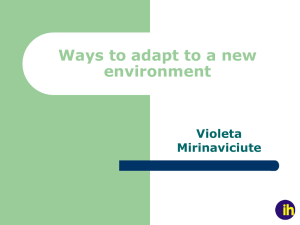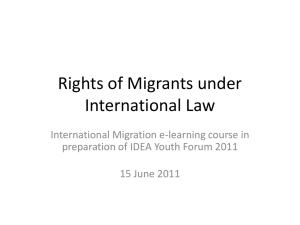file - BioMed Central
advertisement
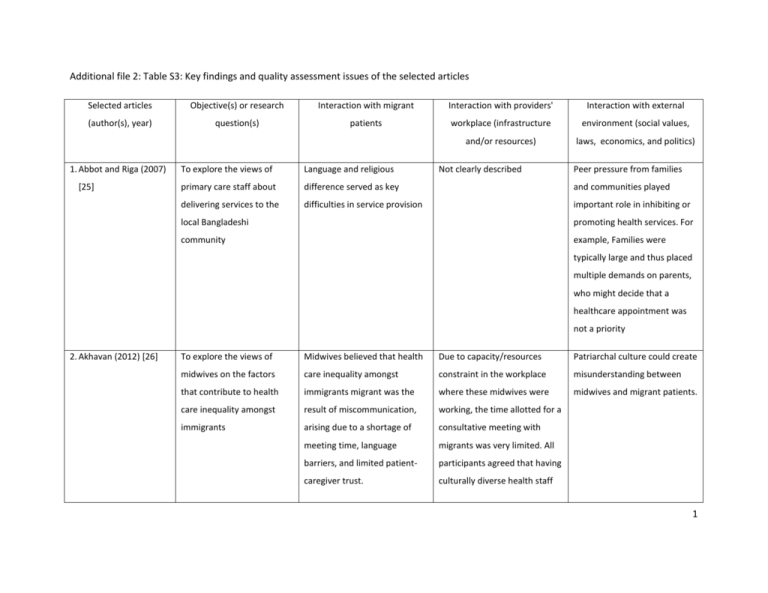
Additional file 2: Table S3: Key findings and quality assessment issues of the selected articles Selected articles Objective(s) or research Interaction with migrant Interaction with providers' Interaction with external (author(s), year) question(s) patients workplace (infrastructure environment (social values, and/or resources) laws, economics, and politics) 1. Abbot and Riga (2007) [25] To explore the views of Language and religious Not clearly described Peer pressure from families primary care staff about difference served as key and communities played delivering services to the difficulties in service provision important role in inhibiting or local Bangladeshi promoting health services. For community example, Families were typically large and thus placed multiple demands on parents, who might decide that a healthcare appointment was not a priority 2. Akhavan (2012) [26] To explore the views of Midwives believed that health Due to capacity/resources Patriarchal culture could create midwives on the factors care inequality amongst constraint in the workplace misunderstanding between that contribute to health immigrants migrant was the where these midwives were midwives and migrant patients. care inequality amongst result of miscommunication, working, the time allotted for a immigrants arising due to a shortage of consultative meeting with meeting time, language migrants was very limited. All barriers, and limited patient- participants agreed that having caregiver trust. culturally diverse health staff 1 Selected articles Objective(s) or research Interaction with migrant Interaction with providers' Interaction with external (author(s), year) question(s) patients workplace (infrastructure environment (social values, and/or resources) laws, economics, and politics) was important in providing culturally sensitive care. Yet, some participants considered another way by stating that having subgroup-specific health services might lead to poorer quality of care because qualified health staff were likely refuse to work in such areas. 3. Boerleider et al (2014) [27] (1) How do Dutch Maternal MCAs often found that migrant Telephone professional Family involvement played a Care Assistants (MCAs) feel clients had limited knowledge interpreters were asked to help pivotal role in maternity care. about providing care to in maternity care. Language MCAs in communicating with MCAs needed to put more non-western clients?; and difference also served as non-western mothers. effort in understanding cultural (2) Do Dutch MCAs adjust another barrier in health However, this service was not values of their clients. Unusual their care to non-western education. Some MCAs always available. customs, such as a husband clients and if so in what described caring non-Dutch refusing to shake hands, could ways? speaking mothers intensive be perceived as an offence, but and sometimes frustrating. should be respected. 2 Selected articles Objective(s) or research Interaction with migrant Interaction with providers' Interaction with external (author(s), year) question(s) patients workplace (infrastructure environment (social values, and/or resources) laws, economics, and politics) 4. Briones-Vozmediano et al (2014) [28] 5. Byrskog et al (2015) [29] To explore the experience Some providers felt frustrated Some professionals attributed Many immigrant women, of service providers in with the decision of immigrant the abandonment of the help especially those in Arab Spain concerning their daily women, particularly those seeking process of a victim to families, failed to escape the professional encountered living in low socioeconomic the failure of the system and violence cycle due to the with battered immigrant status, who abandoned the the ineffectiveness of existing submission to patriarchal women health seeking process due to resources (lodging an official belief. ignorance of the system. complain but no solution). To explore ways antenatal Almost all midwife informants Not clearly described care midwives in Sweden broached questions about that in relation to the Somali work with Somali born violence exposure with Somali born women, they lacked the women and the questions born women, but they rarely background information vis-à- of exposure to violence. encountered ongoing violence. vis cultural and religious Limited communication and conceptions of health, family divergent life situations led to life, value systems, and barriers in determining violence, which might hinder violence towards Somali born the quality of care. Some midwives experienced women. 6. Cross and Bloomer (1) To explore how mental Participants in this study health clinicians modify recognised language as one of Not clearly described Participants in this study tried to understand the belief 3 Selected articles Objective(s) or research Interaction with migrant Interaction with providers' Interaction with external (author(s), year) question(s) patients workplace (infrastructure environment (social values, and/or resources) laws, economics, and politics) (2010) [30] their communication the communication difficulties. systems of the many cultural practice to address cultural Besides, gender role in migrant groups they were caring. Some differences and promote community was another issue migrant communities still client self-disclosure; and that made patients adapted understood that mental illness (2) To identify the practical their approach. In cases of was a punishment from god or experiences that clinicians sexual assault, abuse and superstition. have used when interacting childhood trauma, female with people from culturally clinicians were preferred. diverse groups 7. Dauvrin et al (2012) [31] To investigate the Health workers in accident and Professionals in primary care Even in countries with full experiences of health emergency (A&E) departments and mental health services felt rights of health care access for professionals in providing reported less of a difference more difficulties in performing irregular migrants, there were care to irregular migrants in between the care for migrant further diagnostic and/or still problems when referral three types of health care patients and for native patients therapeutic interventions due was needed. Delay of service (maternity care, in a regular situation than did to the restriction against health treatment occurred frequently accident & emergency care, respondents in primary care care access of irregular as providers and patients and primary care) across 16 and mental health services. migrants. Some clinicians needed to wait until legal issue European countries* Concern over language solved this nuisance by of the patients was resolved. differences was more apparent prescribing medicines for their Notifying police was a rare in mental health services than own names if patients cannot practice, even in countries 4 Selected articles Objective(s) or research Interaction with migrant Interaction with providers' Interaction with external (author(s), year) question(s) patients workplace (infrastructure environment (social values, and/or resources) laws, economics, and politics) in A&E departments. afford the drug expense. where healthcare providers were obliged to do so. 8. Donnelly and McKellin (2007) [32] To understand views of The majority of healthcare Healthcare providers adpate The study suggested that the healthcare providers in provider informants were their routine pracitces to Canadian government paid catering breast and cervical aware that Vietnamese women facilitate the service use of little attention on the cancer screening services were hesitant and Vietnamese women by promotion of cancer screening for Vietnamese women in embarrassed about breast and providing flexible hours of and specifically for the Candata cervical examination due to operation for the healthcare Vietnamese migrants. This was cultural differences. clinic, physicians reminding identified as the most women of their check-ups, and significant barrier to screening having more accessible services. In some provinces, educational materials for services for immigrants had women suffered the biggest funding cut backs. 9. Eklof et al (2015) [33] To describe nurses Nurses were usually aware of The ordering and availability of In Finland, there were several perceptions when using the importance of interpreters interpreters seemed to be regulations regarding the use interpreters in primary in tackling language differences challenging and time- of interpreters. The health care nursing with of their migrant clients. consuming. With references to interpreting costs in health migrant patients However, some nurses some nurses’ experience, care were paid for by the 5 Selected articles Objective(s) or research Interaction with migrant Interaction with providers' Interaction with external (author(s), year) question(s) patients workplace (infrastructure environment (social values, and/or resources) laws, economics, and politics) considered interpreters as access to the interpreter government if the patient was translation machines and as service by phone was difficult a asylum seeker and being in cultural brokers. and increased workload, an integration program; if not, specifically in urgent situations. the costs would be paid by a municipality, which usually had strict guidelines for the use of interpreters. This contributed to a number of hurdles in service provision. 10. Englund and Rydstrom (2012) [34] To gain a broader insight of Health professional informants Not clearly described A strong belief in some families the challenges healthcare perceived that language that trusted male physicians professionals faces in their differences and unfamiliarity far over female nurses could encounters with non- with the western medicine of create uncomfortable feeling western immigrant parents immigrant families sometimes and sense of powerlessness in of children with asthma created frustration and female nurses. Despite having conflicts between healthcare telephone consultation service providers and their clients. by nurses in Swedish healthcare system, many immigrant families only accepted personal contact with 6 Selected articles Objective(s) or research Interaction with migrant Interaction with providers' Interaction with external (author(s), year) question(s) patients workplace (infrastructure environment (social values, and/or resources) laws, economics, and politics) (male) physician instead of using nurse-led telephone advice. 11. Farley et al (2014) [35] To explore enabling factors Participants described Interpreter services were a and barriers healthcare communication difficulties as crucial enabler of refugee providers experienced in one of the most important health care but were also time providing care to refugees barriers to refugee health care. consuming, often unavailable Not clearly described and sometimes of questionable reliability. 12. Foley (2005) [36] To examine perspectives of The provider informants Nurses and social workers at In order to be insured at the medical practitioners and expressed a keen awareness of times adapted the routine city heath centres, patients social workers that were the broad cultural gulf that service guideline of a facility in must first provide proof of bestowing clinical care and secluded them from their order to better suit residence in the city of support services to African African patients. The difficulty expectation and cultural belief Philadelphia. Yet, African immigrants living with of communicating effectively of African HIV patients. These women often had no HIV/AIDS with patients who had little or strategies included giving documentation in their own no formal education and African patients their name because they lived with limited English or French medications in unlabelled male partners or relatives. In fluency was their greatest bottles, delivery of medications spite of these difficulties, many 7 Selected articles Objective(s) or research Interaction with migrant Interaction with providers' Interaction with external (author(s), year) question(s) patients workplace (infrastructure environment (social values, and/or resources) laws, economics, and politics) frustration. to locations other than their case managers, nurses, and patients’ homes, and helping social workers found ways to women negotiate condom use assist both documented and with male partners without undocumented patients disclosing their HIV status. without health insurance through several strategies, such as asking for fund from special government programmes or from other supporting agencies. 13. Fowler et al (2005) [37] To investigate the main Not clearly described Many health professional The Canadian regulation challenges and successes of respondents expressed allowed Kosovars to received the Kosovar arrival, from concern over the location of medical care through the international, national, and medical records and the Interim Federal Health (IFH) local perspectives inability to access this programme. However, some information in a timely manner services were not covered for since the information system free of charge (home health of a Canadian health facility care, eye glasses for refractive was not integrated with that in error, etc). This confusion the country of origin of the rendered difficulties on 8 Selected articles Objective(s) or research Interaction with migrant Interaction with providers' Interaction with external (author(s), year) question(s) patients workplace (infrastructure environment (social values, and/or resources) laws, economics, and politics) 14. Goldabe and Okuyemi (2011) [38] To explore attitudes of Not clearly described refugees. healthcare providers. Not clearly described Normally, by law, providers in Costa Rica undocumented migrants were concerning deservingness to barred against public health care of Nicaraguan services with only 3 exceptions, undocumented migrants namely, emergency services, health care for children and adolescent until age 18 years, and prenatal care. Providers, however, considered undocumented migrants should not deserve medical treatment for occupational injuries as profits did not benefit health of the national population but went to individual companies. 15. Hakonsen et al (2014) [39] To determine the cultural The pharmacist participants Not clearly described The lack of public interpreter barriers met by Norwegian found that the presence of services in community community pharmacists in language barrier made the pharmacies was a dilemma 9 Selected articles Objective(s) or research Interaction with migrant Interaction with providers' Interaction with external (author(s), year) question(s) patients workplace (infrastructure environment (social values, and/or resources) laws, economics, and politics) 16. Health Protection Agency (2010) [40] providing service to non- service provision for non- since Norwegian regulations western immigrant patients western immigrants did not allow unskilled persons and to outline how they challenging, and they were to act as interpreters. This were being addressed uncomfortable with situations situation was contradicting the where family or friends acted hospital service guideline as interpreters, especially where professional children. interpreters might be required. To analyse the use of Respondents expressed Not clearly described Respondents briefly described services in various types of concerns about language confusion in the National migrants in UK and to barriers, which impeded the Health Service (NHS)'s investigate the needs of provision of effective services, regulation. The UK health professionals working with in particular, mental health professionals thus entrusted migrant patients care. non-statutory organisations or civil networks to some services (eg, housing aid) which were not regularly available to certain migrant groups, eg, vulnerable adults, migrants' relatives and dependants. 17. Hoye and To explore the perception of The ICU nurses became The multicultural families ICU nurses felt that, due to 10 Selected articles Objective(s) or research Interaction with migrant Interaction with providers' Interaction with external (author(s), year) question(s) patients workplace (infrastructure environment (social values, and/or resources) laws, economics, and politics) Severinsson (2008) intensive care unit (ICU) insecure when they were seemed to expanded, relative patriarchal views held by [41] nurses with regards to their encountering cultural to Norwegian families. The immigrant families, female encounters with families of differences. situations that produced stress nurses often received lack of were characterised by rooms respect from the ethnic crowded with family members groups. culturally diverse patients and large numbers of visitors, which might hamper nursing procedures in the patient’s room. 18. Hultsjo and Hjelm (2005) [42] To identify if healthcare All respondents expressed Difficulties in finding an staff in somatic and serious concerns over language interpreter, especially at night, psychiatric emergency care barrier and difficulty to address and minority language, and experienced any problems the traumatic experiences of shortage of healthcare staff in the services for migrants migrants. were regarded as the main Not clearly described setback in service provision in all ward types. 19. Kurth et al (2010) [43] To explore the perceptions Language barriers were Not clearly described The Swiss government of healthcare professionals identified as a major struggle attempted to reduce health caring for asylum seeking for health professionals in expenditure by limiting the women in the Women’s providing care. Health care asylum seekers’ choice of 11 Selected articles Objective(s) or research Interaction with migrant Interaction with providers' Interaction with external (author(s), year) question(s) patients workplace (infrastructure environment (social values, and/or resources) laws, economics, and politics) Clinic of the University providers also met major where to seek care and Hospital in the city of Basel, emotional challenges when assigning them to primary Switzerland taking care of asylum seekers. health care providers’ networks, so called, Health Maintenance Organisation (HMO). The problems, faced by physicians, were that they were often required to act in an official capacity on behalf of the authorities in charge of the asylum process, and they were also forced to make decisions in controlling expenditure to fulfill the requirements of the HMO. 20. Lindsay et al (2012) [44] To obtain a better Healthcare and community Though professional understanding of the service providers often interpreters were available, the experiences of service encountered several use of professional interpreters providers working with challenges (such as language was quite limited since it immigrant families raising difficulties, unfamiliarity with always added time on the Not clearly described 12 Selected articles Objective(s) or research Interaction with migrant Interaction with providers' Interaction with external (author(s), year) question(s) patients workplace (infrastructure environment (social values, and/or resources) laws, economics, and politics) children with physical Canadian health system of a disability patient, and discrepancy in the clients' appointment. view concerning disability) in providing care to immigrant families. 21. Lyberg et al (2012) [45] To illuminate public health Respondents experienced that Respondents complained over nurses' and midwives' general maternal care for the quality and availability of perceptions of managing Norwegian mothers did not interpreting service in their and supporting prenatal and match needs of female workplaces. Male interpreters postnatal migrant patients migrants. Posters and leaflets did not understand in Norway were at times too abstract. vocabularies commonly used in Linguistic and cultural barriers maternal care, and this could of migrants often shaped how create distrust between providers delivered services. providers and patients. Not clearly described Some respondents considered videotape education instead of face-to-face meeting was more useful in keeping patients' privacy. 13 Selected articles Objective(s) or research Interaction with migrant Interaction with providers' Interaction with external (author(s), year) question(s) patients workplace (infrastructure environment (social values, and/or resources) laws, economics, and politics) 22. Manirankunda et al (2012) [46] To identify physicians’ HIV Some health professionals Not clearly described The issues of racism and shaky testing practices and were ignorant of the high legal status of immigrants barriers to managing prevalence of HIV epidemic considerably affected the provider-initiated HIV amongst SAMs. Lack of decision of doctors in testing and counselling expertise in discussing undertaking PITC. Some (PITC) for Sub-Saharan sexuality and lack of time also doctors felt that carrying out African migrants (SAM) in served as key barriers in an HIV test amongst Belgium implementing PITC. undocumented migrants who might be deported at any time was unethical since they could not assure proper follow-up care. Some providers perceived promoting PITC for SAMs as a discriminatory practice, and might make them being fear of being accused of racism when suggesting an HIV test. 23. Munro et al (2013) [47] To explore the perspectives Poverty and lack of Logistically, physicians had Many respondents altered of family physicians who understanding in the difficulty accessing prenatal standard of care in order to provided services to Canadian's insurance system resources for their uninsured avoid cost incurred on 14 Selected articles Objective(s) or research Interaction with migrant Interaction with providers' Interaction with external (author(s), year) question(s) patients workplace (infrastructure environment (social values, and/or resources) laws, economics, and politics) uninsured pregnant women played a major role in migrant patients. For example, uninsured immigrants, and to with precarious immigration inhibiting access to care of social services were available avoid referrals to specialist status immigrants. Nevertheless, care only to officially recognised physicians. In Canada, refugees of uninsured women was immigrants or refugees. and refugee claimants were generally thought to be a insured through the Interim professional obligation, Federal Health Programme. regardless of the woman’s Quebec province imposed a 3- ability to pay. month delay on the acquisition of health insurance for newly arrived immigrants. However, due to administrative delays, some individuals with a right to public insurance found themselves without coverage. 24. Nicholas et al (2014) [48] To examine cross-cultural Language and communication Negligible staff representation Conflicting cultural norms care from the healthcare differences constantly in the ethnicities of families between families and providers' perspective presented barriers between was noted. Limited availability healthcare providers were within two tertiary level families and providers. of complementary and reported to impose inter- Neonatal Intensive Care Healthcare providers alternative treatment options personal friction and feelings Units (NICUs) participants felt that was thought to limit capacity of being misunderstood and 15 Selected articles Objective(s) or research Interaction with migrant Interaction with providers' Interaction with external (author(s), year) question(s) patients workplace (infrastructure environment (social values, and/or resources) laws, economics, and politics) communication attempts were for cross-cultural care. There disrespected. Birthing rites and periodically impeded, was a lack of cultural brokers rituals were identified as reportedly heightened by the and translators. culturally nuanced, yet often intensity and frequent shifting poorly understood and at nature of information in the times, disrespected and NICU. subjected to pejorative judgment. 25. O'mahony and Donnelly (2007) [49] To examine concerns of The participants often Not clearly described All healthcare providers viewed healthcare provider in mentioned that immigrant the cultural and social stigma managing mental health women’s misunderstandings of attached to mental illness as a care for immigrant women Western biomedicine and their key barrier to accessing mental unfamiliarity with mental health services for immigrant health care service affected women. Some respondents how these women sought help. expressed that in many Another difficulty raised was cultures there were significant the immigrant women’s negative feelings towards unfamiliarity with mental mental illness and the taking of health services and lack of medication. awareness in the availability of mental health support. 16 Selected articles Objective(s) or research Interaction with migrant Interaction with providers' Interaction with external (author(s), year) question(s) patients workplace (infrastructure environment (social values, and/or resources) laws, economics, and politics) 26. Otero-Garcia et al (2013) [50] To explore the perceptions Midwives explained that of midwives who provided language and cultural maternity services, differences, including gender including sexual and inequity, were significant reproductive programme, barriers to care. In some for immigrant women immigrant families, decision of Not clearly described Not clearly described Not clearly described men prevailed over women's decision (for example, barring women from family planning). 27. Pergert et al (2008) [51] 28. Rosenberg et al (2006) [52] To gain knowledge about Nurses in paediatric oncology The organisation had adapted how health-care staff unit expressed their concern its usual care policy by continuously resolve over linguistic difference. allocating extra time for obstacles to trans-cultural Several strategies, including immigrant patients, and caring relationships as they non verbal communication striving for a diversity of cared for immigrant families using 'signs' and 'printed healthcare staff in term of in paediatric oncology care information', were used to ethnic background. units. bridge this obstacle. To explore challenges for Some physicians reported that immigrant patients and when language barrier arose, beliefs about the expression of family physicians, involving they were more likely to distress and illness experience Not clearly described Physicians used incorrect 17 Selected articles Objective(s) or research Interaction with migrant Interaction with providers' Interaction with external (author(s), year) question(s) patients workplace (infrastructure environment (social values, and/or resources) laws, economics, and politics) in intercultural by-pass psychosocial aspects of in the patient’s culture. In communication (ICC). the health problem since it was some cases, physicians viewed more time consuming than patient’s behaviours as normal general somatic care. for a person of the given culture (such as tears and rotten words), while the same behaviour would be perceived as psychological distress in another culture. 29. Samarasinghe et al (2010) [53] To describe the promotion Some PCHNs approached Not clearly described Some PHCNs empowered of health in involuntary patients by focusing only on immigrant family members to migrant families in cultural somatic health of individuals as be able to integrate into transition through the views they deemed expanding more Swedish society by working of Swedish primary health than physical health was time- closely with social workers and care nurses (PHCNs) consuming, labour-intensive other healthcare workers, and sometimes costly due to preschool teachers, etc. translation fees. 30. Sandu et al (2013) [54] To investigate professionals’ Interviewees noted a general Not clearly described Divergent belief systems experiences of catering care concern with the development served as explanatory models to immigrants in districts of trust and the particular need for immigrant patients’ 18 Selected articles Objective(s) or research Interaction with migrant Interaction with providers' Interaction with external (author(s), year) question(s) patients workplace (infrastructure environment (social values, and/or resources) laws, economics, and politics) densely populated with to establish it with immigrant experiences of mental illness. immigrants in 16 European patients who might be These might hamper diagnosis countries* distrustful of authorities, or and conflict with the were unfamiliar with the practitioners’ understandings, health care system in a host resulting in differentiating country between certain beliefs and symptoms. Usually, the challenge for practitioners was distinguishing what was a culturally normal response from what was an indication of mental pathology. 31. Straßmayr et al (2012) [56] Objective 1—to identify Respondents pointed out that A general shortage of Experts from the countries that barriers to mental health decisions that should be made resources and limited provided no legal access to care in irregular migrants; by clinicians were usually left capacities in mental health mental health care for irregular Objective 2—to identify to administrative staff with services were reported. migrants beyond emergency how health professionals control over access to care. Problems included long waiting care described this lack of legal tackle these problems in This in turn could result in lists; restricted availability of entitlement as the main real practice irregular migrants being denied psychotherapy and barrier. In addition, a lack of access due to arbitrariness and psychological treatment. awareness amongst care 19 Selected articles Objective(s) or research Interaction with migrant Interaction with providers' Interaction with external (author(s), year) question(s) patients workplace (infrastructure environment (social values, and/or resources) laws, economics, and politics) discrimination. Physicians thus usually providers of what entitlements employed informal networks to health care are in place for and non-government migrants was reported as a organisations to cover these significant barrier since it led to unfilled gaps. irregular migrants being left with a minimum of medical attendance despite having the right to receive care. 32. Suurmond et al (2013) [55] To explore insight in the The respondents felt that specific issues that asylum seekers might have healthcare providers were little knowledge about the way required to address in the their body functions, and care first contacts with newly providers might need to put a arrived asylum seekers. lot of effort in clarifying Not clearly described Not clearly described medical treatment. It was questionable to screen (mental) health problems when there was no guarantee for follow-up care. Thus, not all respondents were not strict to 20 Selected articles Objective(s) or research Interaction with migrant Interaction with providers' Interaction with external (author(s), year) question(s) patients workplace (infrastructure environment (social values, and/or resources) laws, economics, and politics) the screening guideline. 33. Terraza-Nu´n˜ez et al (2011) [57] To analyse health personnel Providing healthcare to Not clearly described Informants ascribed the perceptions concerning the immigrants created feelings of inadequacy of resources to an provision of care to distress, overload and absence of suitable planning immigrant population exhaustion in health on the side of the health professionals, especially in authority (Department of primary care level. Health), as well as to its Communication barriers lethargy in adapting the health emerged as one of the main system (physical and human problems. resources, regulations and clinical instruments) to the ‘‘sudden’’ increase in population size and needs of immigrants’ population. 34. van den Ameele et al (2013) [58] To identify the current role Respondents acknowledged Limitations of the Moroccan Participants considered it was and position of the the need for appropriate public health sector re the their responsibility to provide healthcare sector in prevention of sexual violence response to sexual violence evidence of the violence and to Morocco towards the against migrants, but included Insufficient staffing, refer immigrant victims to legal prevention of sexual differences in language, beliefs structures and resources. assistance. However, some violence against sub- and cultures, occasionally, Accordingly, in practice, several providers viewed that 21 Selected articles Objective(s) or research Interaction with migrant Interaction with providers' Interaction with external (author(s), year) question(s) patients workplace (infrastructure environment (social values, and/or resources) laws, economics, and politics) Saharan migrants encumbered health care informants indicated that reporting the presence of workers to tracking traumatic Trans-migrants relied entirely illegal migrants to police would experiences and indentifying on help from NGOs. increase risk of being victim cases. deported, and such practice also contradicted the professional norm. 35. Vangen et al (2004) [59] To explore how perinatal Health care professionals were The communication between care practice might uncertain about delivery outpatient clinics and the influence labour outcomes procedures for infibulated hospitals re the management amongst circumcised women and occasionally of infibulation was poor. The women. caesarean sections were done antenatal clinics had stopped in lieu of defibulation. Neglect referring women to the of circumcision might lead to hospital for antenatal unnecessary caesarean defibulation since their sections or even adverse birth requests had been refused. Not clearly described outcomes. 36. Wachtler et al (2006) [60] to examine how GPs conducted their consultations with consultations with immigrant immigrant patients were patients in the same way that understood by general they conducted all their Not clearly described Not clearly described 22 Selected articles Objective(s) or research Interaction with migrant Interaction with providers' Interaction with external (author(s), year) question(s) patients workplace (infrastructure environment (social values, and/or resources) laws, economics, and politics) practitioners (GPs) and how consultations. These culturally GPs managed these charged consultations were consultations difficult, emotional, and led to a feeling of failure if the GPs felt they had no way of solving the problem of failed communication, and therefore could not be a good physician to their patients. 37. Worth et al (2009) [61] To examine the experiences Most healthcare and social Health care services often of South Asian Sikh and care professionals expressed faced difficulty in managing Muslim patients (and their intentions to provide equitable basic needs under Muslim families) in Scotland with care both migrants and normal culture, such as, the Halal diet, life limiting illness and to citizens, but their aim was and need for specific hygiene identify how to overcome hampered by language practices, such as Wudu (ritual these problems difficulties and lack of ablution preceding daily understanding of Muslim prayers), which were not culture/tradition. The situation usually prepared in the routine was more complicated when practice. Not clearly described engaging with life limited 23 Selected articles Objective(s) or research Interaction with migrant Interaction with providers' Interaction with external (author(s), year) question(s) patients workplace (infrastructure environment (social values, and/or resources) laws, economics, and politics) illness, where bereavement, death and dying came into play since emotional troubles were difficult to address openly. Note: * Austria, Belgium, Denmark, Finland, France, Italy, Lithuania, Germany, Greece, Hungary, the Netherlands, Poland, Portugal, Spain, Sweden, and the United Kingdom 24


